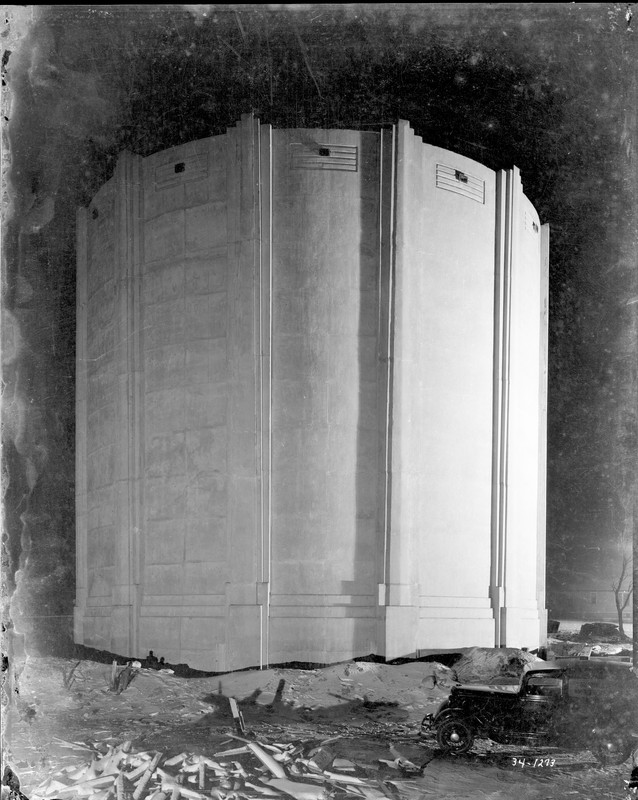Fourth Street Reservoir
Introduction
Text-to-speech Audio
A rare example of Art Deco in the City of Waukesha, this unique private residence began as a water tower. Prior to it's construction, a wrought iron reservoir tank was built at this 4th street location. With demand for water increasing in the city, projects to modernize the city's water infrastructure included construction of more reservoirs for storing water. After the success of other reservoirs in the city, construction began in 1934 to replace the Fourth Street Reservoir with a design by architect Martin White. Though some residents were opposed to the new design, in the end it was well received.
Images

Backstory and Context
Text-to-speech Audio
With a reputation as a city of springs, by the 1880's the Waukesha Water Utility faced immense pressure to improve the municipal water service. An ordinance in November 1886 granted the New England Construction Company of Boston, MA a 20 year contract to build and operate the city's first utility service. Their pump station was located at North and Delafield, and fed eight miles of water main line and eighty fire hydrants throughout the city. They also built a 40' x 40' wrought iron reservoir tank at this 4th street site.
In 1907, the City put a special referendum before voters to make the utility public - it passed 1131 for and 248 against. A water utility commission took control of the water utility and over the next two decades the city began a policy of drilling additional shallow wells to feed the utility. In 1929, it was decided that a deeper well was needed for the growing community and demand for water. A 1630 foot deep well was drilled at Mooreland Blvd and was added to the main service. This well operated by pumping directly into the mains, bypassing the above ground reservoirs.
By 1931, the water utility commission hired Civil Engineer Arthur P Kuranz as the Superintendent. Enlisting the services of Martin C White, architect on staff at the Wilber Lumber Company, the Water Utility began a program of deep drilled wells with a surface reservoir on site that allowed water to be held. The result was successful, as the well capacity was more than doubled. The first such reservoir was installed at the Mooreland Blvd well, with another soon after at the Baxter Street well.
With the success of these projects, Kuranz looked to further secure water and called for the design and construction of a reservoir on the 4th street property that could hold 1 million gallons of water, or enough to supply the city for 24 hours in an emergency. White again provided the architectural design. He had to consider the location of the new tower, a fairly prominent location as it was on a high hill in a residential area of town. Though some opposed the design, the 50 ft diameter, 46 feet tall circular Art Deco reservoir built with a reinforced concrete system consisting of both a 10 inch inner and a 4 inch exterior concrete shell was well received in the end.
White recounted the effect of his unusually styled building in the city:
Three new structures - the last and largest (the Fourth Street Reservoir) - just completed - built in recent years by the water department or the City of Waukesha, Wis., demonstrate the striking architectural possibilities of monolithic concrete even when applied to structures that are strictly utilitarian in character. All the structures, though located in residential areas of the city and at first violently opposed by the residents, are now regarded as definite neighborhood assets. In the matter of economy the results obtained at Waukesha are equally gratifying.1
As hoped for, the result of the new reservoir was an improvement in the fire safety rating for the city - resulting in a 5% reduction in rates for commercial and industrial districts in the city. This expansion supported the city's water supply needs through the end of World War II. In 2003, the building was purchased from the city of Waukesha and converted into private residence.
Sources
Kuranz, A.P. "Public Utilities Dress Up with Architectural Concrete." Concrete. Chicago: Portland Concrete Association, Vol. XLIII, No. 4. April 1935.
Hegglund, Tim. Martin White: An Art Deco Legacy. Landmark. December 1st, 1999. 28 - 36.
Wisconsin Historical Society. 640 Lawnsdale Ave, AHI: Property Record. Accessed October 8th, 2022. https://www.wisconsinhistory.org/Records/Property/HI94401.
Photography Collection, Waukesha County Historical Society & Museum
